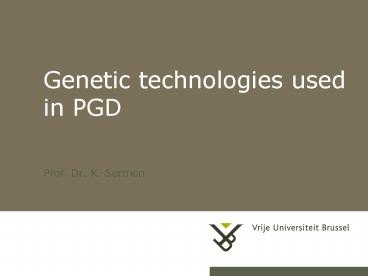Genetic technologies used in PGD - PowerPoint PPT Presentation
1 / 27
Title:
Genetic technologies used in PGD
Description:
An early form of prenatal diagnosis. For couples at high risk PGD ... Pre-clinical tests on single cells (lymphocytes, fibroblasts, amniocytes, ... – PowerPoint PPT presentation
Number of Views:1224
Avg rating:3.0/5.0
Title: Genetic technologies used in PGD
1
Genetic technologies used in PGD
- Prof. Dr. K. Sermon
2
What is PGD?
- An early form of prenatal diagnosis
- For couples at high risk ? PGD
- E.g. monogenic disease, chromosomal abnormalities
- For couples at low risk ? PGS
- To improve IVF results in e.g. patients with
increased maternal age
3
ART and PGD
- More aggressive stimulation to obtain more
embryos - Usually ICSI
- To avoid contamination in PCR
- To avoid fertilisation failure
- Biopsy of one or two blastomeres
- Alternatives polar bodies or blastocysts
4
ICSI
5
Evolution of the embryo
18h
D2
D2
D5
D3
D4
6
Biopsy at cleavage stage
7
Blastomere spreading
- Blastomere is put on glass slide
- Cytoplasm and nuclear membrane are removed with
- HCl/Tween20 solution (Coonen et al.)
- Methanol/acetic acid (Tarkowski method)
- Further treatments
- Pepsin to remove proteins
- Paraformaldehyde to fixate proteins
8
Principle of FISH
9
Sexing with 5-colour FISH
10
FISH for aneuploidy screening
- FISH for chromosomes X, Y, 13, 14, 15, 16, 18,
21, 22 - found in miscarriages or live born with
chromosomal aberrations - In order to increase the pregnancy rates after
IVF - In patients with advanced maternal age (gt37)
- With recurrent miscarriages (gt3)
- With repetitive failed IVF (gt3)
- Other indications
11
FISH for structural aberrations
12
FISH for structural aberrations
Scriven PN, Handyside AH, Mackie Ogilvie C.
Prenat Diagn. 1998 Dec18(13)1437 Slide courtesy
P. Scriven
13
Problems with translocations
- Robertsonian translocations 35 transferable
embryos - Reciprocal translocations 22 transferable
embryos! - Poor pregnancy result
- 19 per OR for Robertsonian
- 12 per OR for reciprocal
- Data from ESHRE PGD Cons report VI, Hum Reprod.
2007 Feb22(2)323-36.
14
Sexing by FISH
- Only useful for X-linked recessive diseases
- Half of the discarded males are healthy
- Half of the transferred females are carriers
- Patients usually prefer DNA-specific diagnosis if
possible - 3/4 embryos are healthy
- Healthy males can be selected
- Carrier females can be identified and not
transferred if wanted
15
Polymerase Chain Reaction
16
Factors influencing PGD
- Efficiency and accuracy of PCR at single cell
level - Use of multiplex PCR
- Biopsy of one vs. two cells
17
Factors in single cell PCR
- Efficiency of PCR and ADO same pitfalls
- Lysis method (water vs. ALB)
- PCR method (denaturation T, DNA polymerase)
- Detection method (EtBr vs fluorescent PCR)
- Cell type (lymphocytes vs. blastomeres)
- Contamination important factor in inexperienced
hands and labs with many cycles
18
Single cel PCR methods
Blastomere is tubed
19
Single cel PCR methods
PCR mix is prepared in DNA-free laminar flow
20
Efficiency of PCR-ADO
- Efficiency of more than 90 should be aimed at
- Pre-clinical tests on single cells (lymphocytes,
fibroblasts, amniocytes,) - At least 50 cells in total
- Lower efficiency coincides with higher ADO and
preferential amplification - ADO is most influenced by PCR method
(conventional vs. fluorescent) - ESHRE PGD Consortium guidelines, Hum Reprod. 2005
Jan20(1)35-48
21
Multiplex PCR
Provides control for contamination and ADO E.g.
cystic fibrosis
4 possible offspring
mother
father
p.F508del
IVS17BTA
22
PGD for DM1
23
Comparative genomic hybridisation
Figure courtesy L. Wilton
24
Comparative genomic hybridisation
Figure courtesy L. Wilton
25
Principle of MDA
- Devised for circular DNA
- Isothermal
- Random priming
- Polymerase makes strand and displaces other
strand, e.g. F29 polymerase - Whole genome amplification
Spits et al., 2006, Nature Protocols, Vol 1(4)
1965-1970
26
MDA and PGD
- Use for haplotyping in PGD for monogenic disease
- But high ADO rate, so many markers to be repeated
- Use for array-CGH for PGS or chromosomal
aberrations - Shorter protocol, better resolution
- Combine both the above
27
CGH with microarrays
Test DNA or cDNA
Control DNA or cDNA
Slide courtesy of J. Harper

